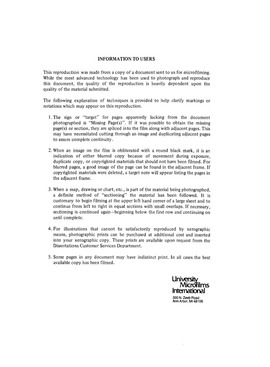| dc.contributor.author | Lancaster, Ivie Wade. | en_US |
| dc.date.accessioned | 2013-08-16T12:28:57Z | |
| dc.date.available | 2013-08-16T12:28:57Z | |
| dc.date.issued | 1983 | en_US |
| dc.identifier.uri | https://hdl.handle.net/11244/5163 | |
| dc.description.abstract | This study focused on how consumers identify, evaluate, and select primary care physicians by examining when the idea of selecting a physician occurred; when the search actually began; the circumstances prompting the search; sources of information used; and choice criteria used in evaluation and selection of a physician. | en_US |
| dc.description.abstract | This study was concerned with the decision process involved in the selection of a primary care physician and compared actual physician selection behavior with that prescribed by health care experts. First a normative model was constructed from general interest literature followed by examining the behavior of consumers who had recently selected a family physician. Both the normative model and the survey instrument used the problem-solving process as an organizing paradigm. | en_US |
| dc.description.abstract | The data allowed for testing the normative model and constructing a positive or descriptive model of primary care physician selection. The following series of conclusions regarding the fundamental premises of the normative model can be drawn. First, not everyone has a primary care physician and those who do tend to have a slightly different demographic profile from those without physicians. Second, consumers tend to be planners and start searching before the need for a physician's service. Third, consumers tend to choose the types of physicians recommended for their primary care. Finally, consumers tend to select their primary care physicians first and then use them in the selection of other physicians. | en_US |
| dc.description.abstract | A second series of conclusions can be drawn about the decision process by comparing the normative and descriptive models. First, it was found that patterns of problems recognition were consistent with those predicted by the normative model. Second, consumers do not start the search process until after moving and most select one, not several candidate's names as predicted by the normative model. Similarly, consumers do not rely heavily on professional sources or physician credentials for information about physicians, and they collect information about the physician at the time of first contact. In sum, it was found that consumers do not follow the step-by-step procedure of the normative model, but instead follow a less rigorous approach. | en_US |
| dc.format.extent | xxv, 497 leaves : | en_US |
| dc.subject | Business Administration, Marketing. | en_US |
| dc.title | An application of marketing theory to health care : | en_US |
| dc.type | Thesis | en_US |
| dc.thesis.degree | Ph.D. | en_US |
| dc.thesis.degreeDiscipline | Michael F. Price College of Business | en_US |
| dc.note | Source: Dissertation Abstracts International, Volume: 44-06, Section: A, page: 1905. | en_US |
| ou.identifier | (UMI)AAI8324891 | en_US |
| ou.group | Michael F. Price College of Business | |
